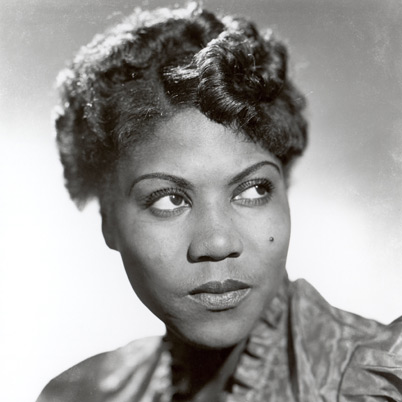Sister Rosetta Tharpe, along with Willie Mae Ford Smith is widely regarded as one of the best Sanctified Gospel singers of her time. A flamboyant performer, whose music often flirted the blues and swing, she also shocked purists by her move into the secular market. By playing nightclubs and theaters she not only helped push spiritual music into mainstream music but also pioneered the rise of pop-gospel. Tharpe was born in Cotton Plant, AR on March 20, 1915. She was the daughter of Katie Bell Nubin who was a traveling preacher and shouter in the traditional gospel tradition “Mother Bell”. Tharpe was a prodigy and had mastered the guitar by age six. She also attended Holiness conventions with her mother, singing renditions of songs such as “The Day Is Past and Gone” and “I Looked Down the Line”. The family moved to Chicago in time and Tharpe started honing her unique style. Her vocal phrasings and guitar style were heavily influenced by the blues. She also embraced the secular world with a unique sense of showmanship, glamour, and showmanship that was unmatched among gospel performers. Tharpe signed to Decca in 1938 and became an overnight star. Her first records, Thomas A. Dorsey’s “Rock Me”, and “This Train”, were huge hits. She was soon performing with mainstream stars like Cab Calloway or Benny Goodman. Tharpe lived a nearly schizophrenic life, recording material such as “Precious Lord,” beams of Heaven, and “End of My Journey”, while appealing to her white audience with rearranged spirituals like “Didn’t It Rain” or “Down by the Riverside”. Tharpe, who was one of two black gospel bands to record V-Discs in World War II for American soldiers overseas, was a hugely popular performer. She also toured the country with the Dixie Hummingbirds. She began recording in 1944 with Sammy Price, a boogie-woogie pianist. Their first collaboration, “Strange Things Happening Every Day,” reached the Top Ten on Billboard’s race records. This feat was rare for a gospel artist and was repeated many times throughout her career. She teamed up with Madame Marie Knight (Newark-based Sanctified shouter), in 1946. Her simple, unaffected voice made her the perfect counterpoint to Tharpe’s dramatics. The duo’s first single “Up Above My Head” was a big hit and they continued to play to huge crowds on the church circuit for the next few years. In the early 1950s Tharpe and Knight recorded a few straight blues sides. Their fans were furious and Knight made a permanent move into secular music, to very limited success. However, Tharpe was still a gospel artist and her popularity and credibility were severely damaged. Tharpe’s record sales declined and her live performances became fewer and further between. Many purists also took Tharpe’s foray into mainstream music as an insult. She spent more than a year touring Europe and waiting for the controversy to end. Tharpe’s slow, steady return was not easy. By 1960 she had been able to get back into the good graces of the public enough to perform at the Apollo Theatre with James Cleveland and the Caravans. Although she was not as well-known as before, she still toured after suffering a stroke in 1970. She died in Philadelphia on October 9, 1973.
